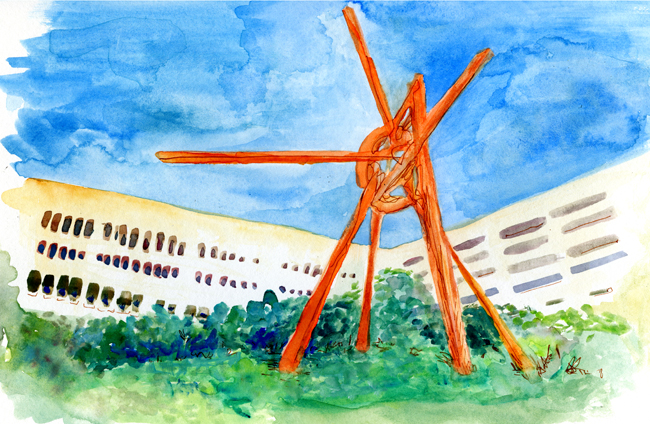The Landmarks program, which arranges for various sculptures and artworks to be displayed across campus, is entering its fifth year of existence and will open its latest piece, James Turrell’s “The Color Inside,” this month.
The Landmarks program launched in 2008 to serve as the University’s public arts program and now contains 35 works, including Turrell’s “Skyspace” at the Student Activity Center. Andree Bober, director for the program since its inception, said the goal of Landmarks is to complement the University’s open spaces and walkways with various and diverse works of art.
“I think that a vibrant public art program should be representative of all the different kinds of production that artists make,” Bober said.
Most of the works under the program do not belong to the University. In 2008, the Metropolitan Museum of Art in New York loaned the program a collection of 28 artworks that it no longer had space for. Although the University does not own them, the works are displayed on campus through a long-term loan.
“I expect the sculptures to be here for generations,” Bober said. “I don’t think they’re going to be recalled. As far as I can see and imagine into the future, they’re here. They’re for us to be able to enjoy them.”
The University has been adding more projects to the program since it established its agreement with the museum. Each year, the program receives 1 to 2 percent of revenue from the UT System’s Capital Improvement Program, which funds construction and renovation projects at System institutions.
The program acquires art by either purchasing existing works or commissioning new works of art from an artist, Bober said.
Each art project must be approved during an extensive process that runs through several officials and committees at the University, from the Landmarks Advisory Committee to President William Powers Jr., Bober said. Occasionally, the UT System Board of Regents must have final approval. To approve additions to the program, Bober said University officials must determine whether or not each project fits a set of criteria. For example, no project can make a political statement or be unsafe.
Robin Williams, the student representative on the advisory committee and an art history graduate student, said the Landmarks program strongly contributes to the appearance of the campus.
“We’re, in a sense, connecting our community to a significant cultural community outside of us,” Williams said.
To help conserve the artworks, the program uses a group of student interns called the Landmarks Preservation Guild. The interns learn about art conservation while taking care of the different sculptures and works across campus.
Sarah Hunter, guild member and historic preservation graduate student, said each work of art must be taken care of differently because of its materials, structure and location on campus. Hunter said most of the work involves inspecting the art piece.
“A large portion of your time spent with the sculpture is not actually touching the sculpture or cleaning it,” Hunter said. “It’s really observing the changes and observing the piece on a very intimate level.”















